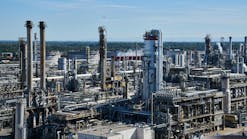Allan Mortimer
MDC Technology Ltd.
Middlesbrough, U.K.
Mobil North Sea's SAGE gas terminal at St. Fergus, Scotland, has installed a system that allows operators a wider range of responses to inlet conditions and processing targets.
Mobil North Sea Ltd. has installed an operator guidance tool at its SAGE gas-processing plant at St. Fergus, Scotland (SAGE: Scottish Area Gas Evacuation).
The system, supplied by MDC Technology, Teesside, U.K., will aid process decision making at the plant under MDC Technology's RTO+ software.
In addition, Shell U.K. Exploration & Production (Shell Expro) has installed a pipeline-scheduling system, also supplied by MDC Technology, at its Aberdeen control center. The system aids gas-movement scheduling through Shell Expro's St. Fergus gas plant.
The Northern Systems and Plant Scheduling (NSPS) system integrates MDC Technology's RTO+ package with Microsoft Visual Basic and Excel.
Supply complications
Mobil's SAGE gas terminal at St. Fergus has two identical process trains (NGL recovery and acid-gas treatment), each with a capacity of 16.25 million std. cu m/day (MMcmd; 569 MMcfd).The terminal takes gas feed from the Beryl, Brae, and Scott fields via a common pipeline. It delivers sales-quality gas to BG Transco and NGL to Shell Expro's Fife NGL plant at Mossmorran and to BP Exploration Operating Co. Ltd.'s Forties liquids pipeline system.
The terminal was expanded earlier this year with a new process train to handle Britannia field gas at a design rate of 21 MMcmd. This venture is referred to as the SAGE terminal extension (STE) project (Fig. 1 [48,817 bytes]).
Operation of the existing plant is complicated by the diversity of the three field-gas compositions. Introduction of the Britannia train adds further complexity.
Mobil has two separate pipelines from which to draw gas to meet nominations. Introduction of the third train increases operational options at the plant. Mobil must therefore balance limited steam resources between existing and new trains.
The operating philosophy of the SAGE terminal is geared to supplying sales gas to meet specific nomination and quality targets. NGL products, though valuable, are of secondary importance.
One of the major potential operational costs for the SAGE terminal is absorbent use incurred in the sales-gas polishing beds. These beds are used to reduce the H2S present in the product gas to within sales-gas specifications.
Prior operation ensured these levels could typically be achieved via H2S removal in the gas sweetening (amine) columns without need for further gas polishing. However, Britannia gas significantly differs from SAGE composition.
Once the new STE train is operational, the necessary gas blending will potentially require more H2S removal via the SAGE train gas-polishing beds.
The company recognized the need for a computer tool to advise operators how to operate the extended plant efficiently.
Guidance tool
MDC Technology delivered a real-time open loop (advisory) tool that advises the operators how to respond to the entire range of inlet states and processing targets they will encounter. This "tool" is referred to as the operator guidance tool.The system was built with MDC Technology's real-time modeling and optimization package, RTO+. It is based on a Windows NT platform, with access possible from elsewhere on the Mobil site network.
The guidance tool is designed to minimize this operating cost while achieving the sales-gas nomination and blend-quality specifications.
The system has been designed and built with future extension to closed-loop operation in mind.
The guidance tool consists of the following:
- Unit models of the key process equipment including turboexpander units, stabilization columns, heat exchangers, and amine-based gas sweetening columns.
- An online base-case model of the three process trains automatically updated from process measurements.
- An online open-loop optimizer advising on the optimal setpoint values for both current and forecast operation.
- An offline "what-if" tool with live process data links for detailed simulation and optimization studies.
- Dedicated user interfaces for both online and offline tools designed for ease of use.
- Links to site's plant information system. PI, from OSI Software Inc., is part of MDC Technology's plant-solution package.
Scheduling aid
At its Aberdeen scheduling center, Shell Expro has installed an MDC Technology-supplied system to support planning activities associated with the gas contracts in the northern North Sea sectors.Contracts for gas supply in the U.K. sector of the North Sea are both numerous and complex. Schedulers are responsible for administering the gas operations on behalf of Shell Expro and the various partners associated with each platform and field in the sector.
They must daily balance gas landed at Shell Expro's St. Fergus gas plant with a range of contractual constraints, including quantity and quality of gas exported and ethane supplied to the Fife NGL plant at Mossmorran.
NSPS installed
The new system Shell Expro purchased is designed to perform short to medium-term planning of gas production from the northern and central North Sea fields, its treatment in the St. Fergus gas plant, and the allocation of the final products back to the contributing fields.The NSPS system considers all the North Sea platforms that deliver their gas ashore through the Far North Liquids and Associated Gas System (Flags) or Fulmar gas pipelines.
It is designed to have the flexibility to handle new fields as well as major changes in operating circumstances (Fig. 2 [61,609 bytes]).
One of the major elements of the system is the technique for combining contractual arrangements (each field nominates, uniquely, how it would like to operate the gas plant) with the capabilities of the plant itself which can only support a single set of conditions at any one time.
NSPS is primarily used to interpret the requirements of the gas schedulers as a set of objectives and constraints for the St. Fergus and Mossmorran plants and, in particular, for their on-line optimizers.
Direct interaction with the process itself will be minimal. Key performance parameters employed in the NSPS, however, will be provided by the on-line optimizers (either direct plant readings or model output data) and dynamic models developed for the Flags and Fulmar pipelines.
The data will be continuously available enabling the NSPS to pick up the most recent values as and when required.
The Author
Allan Mortimer is project manager for MDC Technology Ltd., Middlesbrough, U.K. He has more than 14 years' experience in the implementation of on-line process modeling, optimization, and information systems in various industries including oil and gas production. He holds a BS from Edinburgh University and is a chartered engineer and member of the Institution of Chemical Engineers.
Copyright 1998 Oil & Gas Journal. All Rights Reserved.



